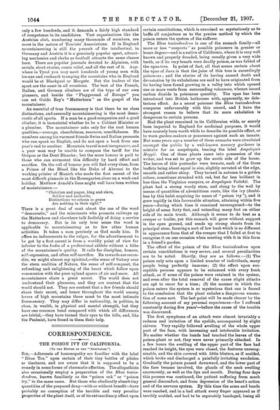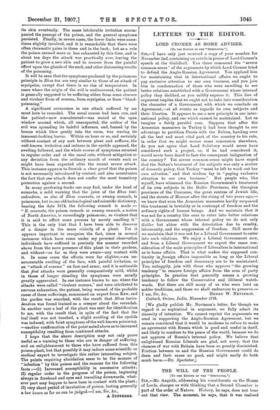CORRESPONDENCE.
THE POISON IVY OF CALIFORNIA.
[To THE EDITOR OP THE " SPECTATOR."1
SIR,—Adherents of homoeopathy are familiar with the label " Rhus Tox." upon certain of their tiny bottles of pilules or tinctures, and are aware that it is supposed to be a remedy in some forms of rheumatic affection. The allopathists also occasionally employ a preparation of the Rhus toxico- dendron, known familiarly as the "poison oak " or "poison ivy," in the same cases. But those who obediently absorb tiny quantities of the prepared drug—with or without benefit—have probably no conception of the terrible and very peculiar properties of the plant itself, or of its extraordinary effect upon certain constitutions, which is exercised so mysteriously as to baffle all conjecture as to the precise method by which the poison enters the system of the sufferer.
The Rhus toxicodendron is one of the sumach family—all more or less " suspects " as possible poisoners in greater or lesser degree—and is a native of California, where it is very well known and properly dreaded, being usually given a very wide berth, as if its very breath were deadly poison, as was fabled of the upas-tree. In point of fact, all that seems certain about the upas of Java is that the juice of this tree is exceedingly poisonous ; and the stories of its having caused death and devastation by its exhalations are said to have originated from its having been found growing in a valley into which opened one or more vents from surrounding volcanoes, whence issued carbon dioxide in poisonous quantity. The upas has been introduced into British hothouses with, apparently, no dele- terious effect. As a secret poisoner the Rhus toxicodendron compares unfavourably with this record, and I have the strongest reason to believe that its mere exhalation is dangerous to certain persons.
Had the plant remained in its Californian wilds, or merely been imported to England for medicinal purposes, it would have scarcely been worth while to describe its possible effect, or to warn garden-makers or possessors against such an inmate. But some years ago a number of these suraachs were circulated amongst. the -public by a well-known nursery gardener in mistake for an ampelopsis, bearing the label Ampelopsis Hoggii. One of these plants came into possession of the writer, and was set to grow up the south side of the house. The leaves of this pretender were ternate, each of the three leaflets being about equal in size, slightly serrated at the edge, smooth and rather shiny. They turned in autumn to a golden colour, sometimes streaked with red, but far less brilliant in hue than the Virginian creepers, or Ampelopsis Veitchii. The plant had a strong woody stem, and clung to the wall by means of quantities of adventitious roots, like the ivy (doubt- less by this habit acquiring its name of "poison ivy "), and it grew rapidly in this favourable situation, attaining within five years—during which time it remained unrecognised—to the height of some forty feet, and extending many feet on either side of its main trunk. Although it seems to do best as a creeper or trailer, yet this sumach will grow without support in the open ground, and sends up strong shoots from its principal stem, forming a sort of low bush which is so different in appearance from that of the creeper that I failed at first to recognise it on one occasion when meeting with it in this form in a friend's garden.
The effect of the poison of the Rhus toxicodendron upon certain constitutions is very severe, and several peculiarities are to be noted. Shortly, they are as follows :—(l) The poison only acts upon a limited number of individuals, many People being perfectly immune; (2) the effect upon sus- ceptible persons appears to be enhanced with every fresh attack, as if some of the poison were retained in the system, and even after the total removal of the cause slight attacks are apt to recur for a time ; (3) the manner in which the poison enters the system is so 'mysterious that one is forced to the conclusion that the plant exhales a dangerous emana- tion of some sort. The last point will be made clearer by the following account of my personal experiences—for I suffered constantly during five years'—before the cause of the trouble was discovered.
The first symptoms of an attack were almost invariably a redness and irritation of the eyelids, accompanied by slight shivers. Very rapidly followed awelling of the whole upper part of the face, with increasing and intolerable irritation. No matter whether the hands had touched the leaves- of the poison-plant or not, they were never primarily attacked. In a few hours the swelling of the upper part of the face had reached its height, the eyes were closed, the features unrecog- nisable, and the skin covered with little blisters, as if scalded, which broke and discharged a painfully irritating exudation. Gradually the poison passed downward, and the lower part of the face became involved, the glands of the neck swelling enormously, as well as the lips and mouth. During four days this process was continued, the patient suffering from much general discomfort, and from depression of the heart's action and of the nervous system. By this time the arms and hands were reached, and in a bad attack every finger appeared as if terribly scalded, and had to be separately bandaged, losing all
its skin eventually. The same intolerable irritation accom- panied the passage of the poison, and the general symptoms persisted. Finally, in severe cases, the lower limbs were some- times slightly involved, and it is remarkable that there were often rheumatic pains in these and in the back; but as a rule the poison seemed more or less exhausted by this time, and in about ten days the attack was practically over, leaving the patient to grow a new skin and to recover from the painful effect upon the glands of the neck, and other distressing results of the poisoning.
It will be seen that the symptoms produced by the poisonous principle in Rhus lox. are very similar to those of an attack of erysipelas, except that there is no rise of temperature. In cases where the origin of the evil is undiscovered, the patient is generally supposed to be suffering either from some obscure and virulent form of eczema, from erysipelas, or from "blood- poisoning."
A significant occurrence in one attack suffered by me must here be recorded. The usual course had been run, and the patient—now convalescent—was seated at the open window around which, all unsuspected, the author of the evil was spreading its baleful influence, and, fanned by the breeze which blew gently into the room, was waving its innocent-looking leaves. Within an hour or so, and certainly without contact of any sort between plant and sufferer, the well-known irritation and redness in the eyelids appeared, the swelling followed, and the whole course of symptoms recurred in regular order and at the usual rate, without mitigation or any deviation from the ordinary march of events such as might have been expected after the recent severe attack. This instance appears to furnish a clear proof that the poison is not necessarily introduced by contact, and also accentuates the fact that one attack does not confer the most transitory protection against a second.
In many gardening-books one may find, under the head of sumachs, a mild warning that the juice of the .Rhus toxi- codendron, as also of Rhus venenata, or swamp sumach, is poisonous, but in one old technological and scientific dictionary, bearing the date 1874, the following remark is made :- " B. venenata, the poison sumach or swamp sumach, a native of North America, is exceedingly poisonous; so virulent that it is said to affect some persons by merely smelling it." This is the only hint that I have been able to discover of a danger in the mere vicinity of a plant. Yet it appears important to recognise the fact, since in several instances which have come under my personal observation individuals have suffered in precisely the manner recorded above from the mere presence of this plant in their gardens, and without—as far as they were aware—any contact with it. In some cases the effects were far slighter,—an un- accountable swelling of the face, with painful irritation, or an "attack of eczema" on face and arms; and it is noticeable that first attacks were generally comparatively mild, whilst in those of longer standing the symptoms were usually greatly aggravated. In one instance known to me, where the attacks were called "virulent eczema," and were attributed to nervous exhaustion, the patient, being warned of the probable cause of these sufferings, summoned an expert from Kew, and the garden was searched, with the result that .Rhus toxico- dendron was found trained as a creeper about the , verandah. In another case a leaf of the plant was sent for identification to me, with the result that, in spite of the fact that the leaf itself was not touched, a slight swelling of the eyelids was induced, with faint symptoms of the well-known poisoning, —another confirmation of the point noted above as to increased susceptibility resulting from continued attacks.
I hope that the above description may not only prove useful as a warning to those who are in danger of suffering, and an enlightenment to those who have suffered from this poison-plant, but that possibly it may induce some scientific or medical expert to investigate this rather interesting subject. The points requiring elucidation seem to be the manner of "infection" by this poison and the reasons for the following facts :—(1) Increased susceptibility in successive attacks;
(2) regular order in the progress of the poison, beginning always in forehead and eyes and travelling downwards, what- ever part may happen to have been in contact with the plant;
(3) very short period of incubation of poison, lasting generally a few Lours as far as can be judged.—I am, Sir, &c., A Sum:ma.















































 Previous page
Previous page